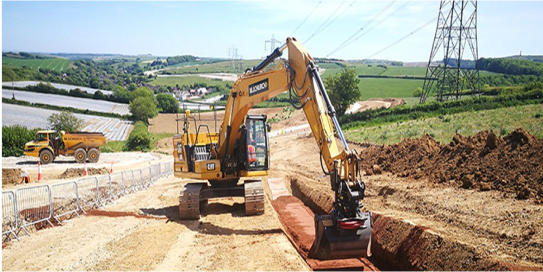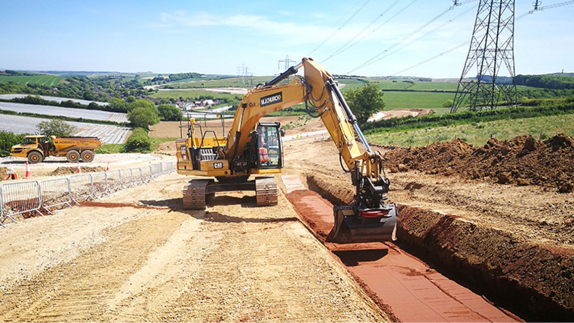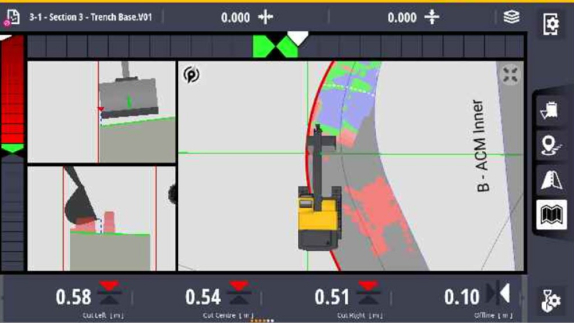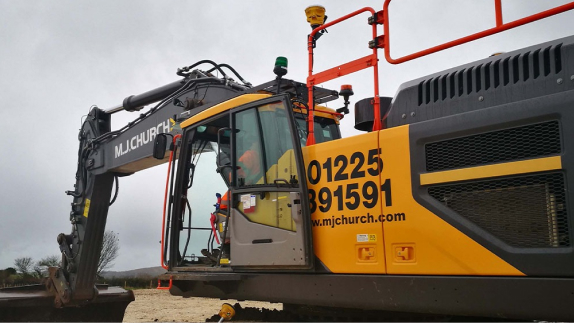by SITECH UK-Ireland | Feb 9, 2021 | Case Study

MJ Church is a medium-sized civil engineering contractor based in South West England. The team delivers large and complex infrastructure projects and runs a successful waste processing operation. MJ Church has a modern fleet of around 170 machines and over 200 vehicles for its own projects and for rental purposes. The company prides itself on a passion for new and innovative technologies to give it a competitive advantage.
Technology is deeply ingrained in the daily operations at MJ Church, the civil engineering contractor from Chippenham (UK). To optimise the efficiency of its modern, multi-brand fleet of construction machinery, the company has developed strong ties with Trimble and SITECH UK & Ireland as their technology providers of choice. So much so that the contractor is involved in beta-testing some of the latest machine control, 3D design, and project monitoring and reporting technology.
Sam Williams is an Engineering Surveyor at MJ Church and, together with Manager Stuart Harry, leads many of the contractor’s efforts to stay at the forefront of technological developments. “Machine control is the future, and we want to be at the right side of the future,” says Williams. “For MJ Church this means that we start every project with the intent of putting machine control in, as we know that it will lead to the greatest efficiency possible.”
Typically, the survey team goes in first and does a pre-entry survey on every site to gather the data necessary to build the schemes and track volumes. In many cases the designs are available but are remodelled to suit the updated terrain information. The team even does most of the 3D design work itself: prepping designs to get them ready to be pushed out to the machine control system. During the course of a project the surveyors are responsible for weekly measures to track production, as well as for the as-built surveys at the end of the projects. Machine control set-up and calibration is also the team’s responsibility. “We want to build our in-house knowledge, to get the most out of the systems,” Williams explains.

A landmark project for MJ Church, that had the contractor put all of its technology and knowledge to work, is the Visual Impact Provision project in the Dorset Area of Outstanding Natural Beauty (AONB): the restoration of a site, designated as an area of outstanding natural beauty, to its former glory. The scheme involves the removal of 400kV overhead power towers to improve the visual appeal of the area. The power is diverted to underground cables nestled in ducts in 4 trenches of 8.5 kilometres each. All this across terrain offering up numerous challenges in terms of steep field crossfalls, longitudinal falls and undulations in the land.
The project started with a topographical survey of the terrain for the full 8.5km corridor. This survey was captured mainly by Trimble GNSS Site Positioning Systems and total stations. Once processed, we imported the terrain data into Trimble Business Center and we use the advanced corridor modelling tools to create a trench base model. We then used Trimble Business Center to combine the survey data with the designs from the project’s main contractor. As these designs come to us mainly as 2D PDF drawings, we need to model the trenches in 3D to be able to use machine control. These 3D designs are then sent over to be approved by the client.
Williams designed each trench by creating a series of symmetrical vertical curves and straight segments which attempt to best fit the terrain. The typical crossfall of the land is sampled every 10m and is mirrored in the trench design surface. The vertical alignment is then optimised to minimise over- and under-excavation. This ensures that the trenches meet the very strict depth requirements (1.41 metres). Then a cut/fill map and high-quality PDF deliverables are created using the drafting functionality in Trimble Business Center, clearly demonstrating compliance with the design specification.
Additionally, in some cases the site presents additional complexity: road crossings for instances or locations where buried services are discovered. The somewhat unique dynamic nature of Trimble Business Center allows MJ Church to rapidly respond to design change requests, which are quite frequent.

Next in the process is the publication of the designs through Trimble Connected Community (TCC), to be pushed to the Trimble Earthworks Grade Control Platform including the in-cab systems of the various earthmoving machines. These machines out in the field then periodically download the designs. “In a case where remodelling is necessary, we can rapidly republish to the machines, ensuring all operators work with the latest 3D models,” Sam explains. “This saves a lot of time and effort, as we no longer need to send one of our surveyors out to the project. Another time-saving feature of the Trimble Earthworks platform is the fact that our operators get full remote support. Even though we’re at different locations, we can work as a team on troubleshooting issues, or on explaining details of the design or some of the system’s inner workings, such as how to align the bucket to a line. Because our operators more and more want to learn how to use Trimble Earthworks to its full potential.”
The use of TCC gives MJ Church the ability to stream local base station corrections to its machines over IBSS (Internet Base Station Service). The use of traditional radio was not practical due to the terrain and size of the project. IBSS allows MJ Church to use its existing equipment in new ways, reducing operation costs.

For MJ Church one of the primary objectives of the Dorset project site was for it to serve as a proving ground, showing that the Trimble grade control platform can be used to prove beyond a reasonable doubt to the customer that the contractor can map the correct depth in the trenches. For this purpose, it is crucial to get correct volume data to the office quickly. Williams: “We basically turn the machine blade or bucket into a surveyor, with its position being captured every 0.2 seconds.” These measurements together form a point cloud, which is updated non-stop and uploaded to the VisionLink 3D Productivity Manager platform. The data can then be visualised and used to generate live volumes. All in all, the team is generating live as built surveys, which are then validated from time to time by traditional validation surveys. Commercially the use of the platform is a great benefit: there is never any discussion on the work that has been done or on the associated costs. But the biggest advantage might very well be the safety aspect. As the surveyors are not allowed to climb into the trenches to capture an as built, they can now confidently use the data from the machines.
VisionLink 3D Productivity Manager, together with Trimble Business Center, also provides the exact volume data, and enables MJ Church to check these against the design surface so the contractor knows that the operators are digging to the correct grade and depth. But the software is also used to continually track topsoil removed and stockpiled. The 3D technology is not only helpful in taking out the exact right amount of soil. In combination with the tilt rotating buckets on the excavators, the software also helps MJ Church put in the right amount of the – quite expensive – Cement Bound Sand at the bottom of the trenches with a high degree of accuracy. “All this means that we’re working safely, keeping costs under control, maximising efficiency in the field and in the office, and ensuring there will be no surprises at the end of the project: no rework,” Williams concludes.